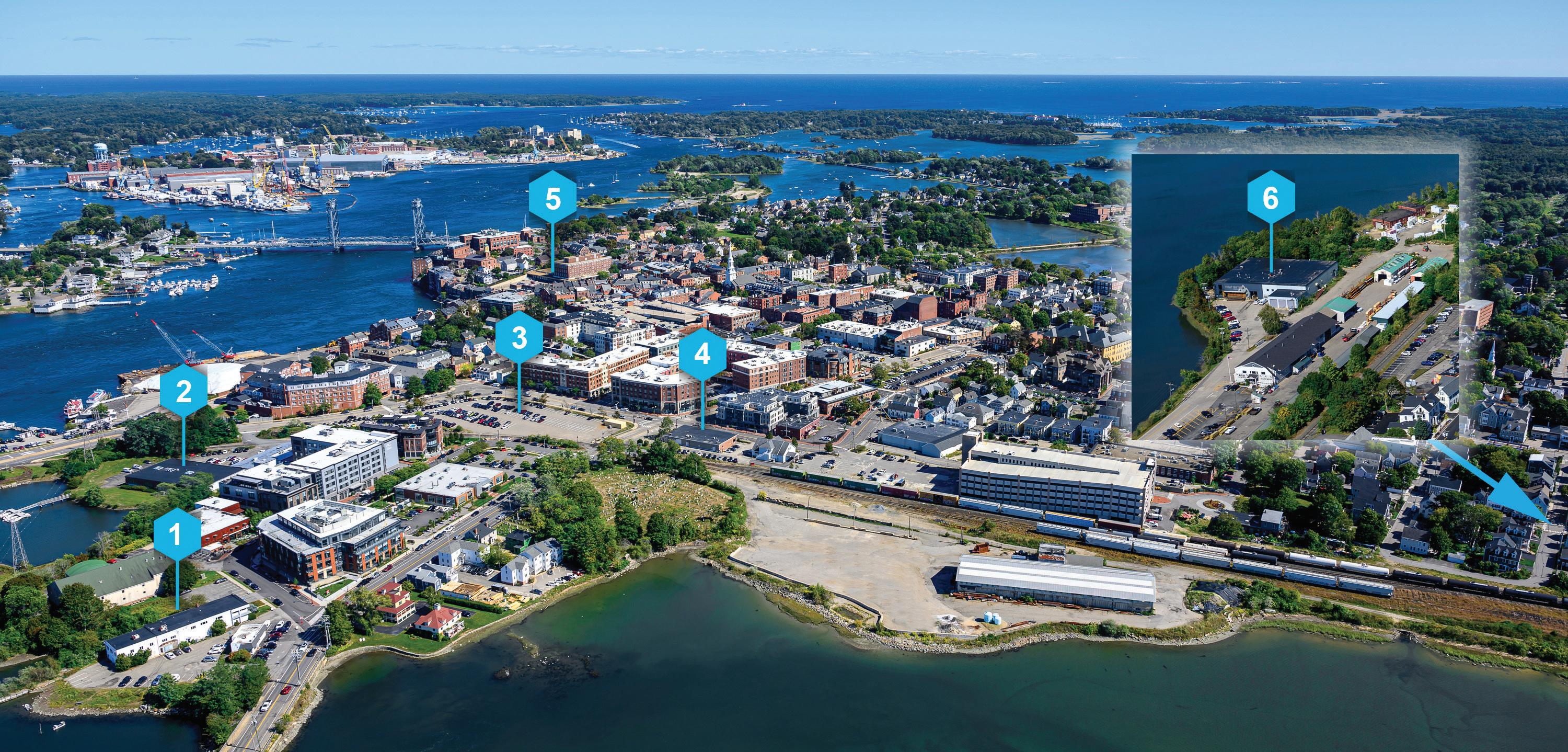NEW HAMPSHIRE MARKET OUTLOOK 2023
































Welcome to our 2023 New Hampshire Market Outlook. Our goal is always to furnish precise, straightforward, and reliable information that can assist our clients and real estate professionals in making informed decisions.
In this annual publication, we look at the current state of the office and industrial markets, including information on demand, availability of properties, and key trends and factors that may impact the market in the coming year. This year we are pleased to provide data for the I-93/Route 3 Corridor, as well as the Seacoast, thus providing a comprehensive state-wide overview of the commercial real estate market.
Over the past year, as we continue to work our way out of the pandemic, New Hampshire has experienced a small uptick in office vacancy, while still seeing a strong demand for industrial space. Overall, New Hampshire’s commercial real estate market has weathered the negative impacts of COVID-19 better than had been predicted. This can be attributed to the state’s strong economy and business-friendly environment, as well as by the availability of a skilled workforce and access to transportation and other amenities.
Looking ahead, we expect office vacancy rates to rise and, in particular, more sublease space to become available. Over the past year, industrial asking lease rates have risen, but we expect that they will plateau in the coming months. Demand will remain strong for high bay industrial space and the lack of buildable land on the Seacoast will push developers to alternative markets throughout the state.
The New Hampshire commercial real estate market has faced various challenges and opportunities in the past year. We would like to take a moment to express our sincere appreciation for the trust and confidence our clients have placed in us. As a company, we value the partnerships we have formed and look forward to working with you in the year ahead!
Sincerely,
Kent White Roger Dieker











The Boulos Company’s Seacoast New Hampshire office, located in Portsmouth, experienced one of its best years since the branch opened over 20 years ago. Even with a severe lack of inventory and very minimal options listed on the market, our team was able to complete a number of significant transactions; a few of which were completely “off market” and a result of relationships that the team has cultivated over the years. As evident from these examples, we have not as yet seen a slowdown in demand for all sectors of commercial real estate on the Seacoast.
Below are highlights of some significant deals completed by our team in 2022:
• 100 Domain Drive: 100 Domain Drive in Exeter, New Hampshire, was sold to Torrington Properties, Inc. by 100 Domain Drive DD & EI, LLC for $46.9 million. The property is a 263,486± SF Class A office building and warehouse off Route 101 and offers an on-site gym and locker rooms for tenants, along with a food vendor serving breakfast and lunch. Several factors, including the building quality, tenant mix, and proximity to I-95 as well as the Boston suburbs, made 100 Domain Drive a great fit for Torrington’s portfolio. Torrington will continue to operate the property as one of the premier Class A buildings in the Seacoast area. The transaction was arranged by Kent White and Caitlin Burke.
• 35 Industrial Way: Amarosa Industrial Park, LLC purchased a two-building campus on 27.64± acres totaling 210,000± SF from The Arthur W. Sullivan Revocable Trust for $6.8 million. The buyer used 1031 exchange proceeds from the sale of 16 Amarosa Drive to purchase 35 and 35E Industrial Drive in Rochester, NH, which is a mix of industrial and office space located in Rochester’s Technology Park. The facility currently has three office vacancies available ranging in size from 5,000-13,000± SF. The transaction was arranged by Christian Stallkamp.
• West End Yards: The West End Yards Development in Portsmouth, NH consists of approximately 50,000± SF of commercial space and over 250 residential apartments. It is owned by Torrington Properties, Inc. The residential apartments were completed by the Fall of 2022, and the commercial spaces are anticipated to be complete by Summer
2023. The most significant transaction at West End Yards in 2022 was that ConvenientMD leased 32,602± SF of office space. They will occupy the entire second floor of Building C as well as a portion of the first floor for their corporate office headquarters. It is a huge expansion for them as they will be occupying four times the amount of space they have in their current location in Portsmouth. ConvenientMD owns and operates 35 walk-in medical clinics in New Hampshire, Maine, and Massachusetts. The transaction was arranged on behalf of the landlord by Caitlin Burke and Kent White.
• 121 Technology Drive: Sig Sauer Real Estate Inc. leased 123,890± SF of industrial space at 121 Technology Drive in Durham, NH, from 121 Tech Owner, LLC. This location will offer more room for Sig Sauer’s expansion. The transaction was arranged on behalf of the tenant by Kent White.
• 5 Perkins Way: The owner of Buy New England Lobster, LLC, a wholesale lobster distribution company, purchased the 8-unit property on 5 Perkins Way in Newburyport, MA for $6.18 million. Two of the eight units will eventually serve as their new headquarters. The other six units are leased to other tenants, with one unit available for lease in October 2022. Caitlin Burke collaborated with the buyer for close to a year in a very competitive market. They considered both sale and lease options from Boston to Portsmouth along I-95. The transaction was arranged on behalf of the buyer by Caitlin Burke and on behalf of the seller by Austin Spinella of Coldwell Banker Realty.

2022 proved to be another busy year with lots of activity. The lack of inventory being “on the market” did not slow transactions down. Investors and users were both busy acquiring off-market properties.
We have highlighted a sample of transactions from our portfolio of sales and leases throughout this past year below. Demand was significant for warehouse and industrial properties throughout Southern New Hampshire.
• RJ Kelly Co. purchased a portfolio of 22 properties in the greater Nashua and Manchester area. RJ Kelly Co. was thrilled to add these to their investment portfolio, as the acquisition fits their long-term investment strategy. “This acquisition adds significant synergies to our growing NH portfolio while providing an excellent opportunity for long term stability and value creation for our investors,” said Brandon Kelly, President and CEO of R.J. Kelly Co.
• Chris Healey of The Boulos Company represented Foxfield LLC in the off-market purchase of 21 Northwestern Drive for $14.9 million. The 100,450± SF industrial/flex property has 15.26± acres and is fully occupied by four tenants. “This was an excellent opportunity to buy a facility with a strong roster of tenants in a dynamic location,” said Managing Partner Jeff Theobald. “We’re excited to see the Southern New Hampshire industrial market continue to develop over the coming years.”
• Roger Dieker assisted EC NH Real Estate Holdings, Inc. in the acquisition of the former Sears retail location at the Pheasant Lane Mall in Nashua NH. The 180,000± SF property on 6.84± acres traded at $14 million. As retail continues to adjust to a post-Covid landscape, many large retail facilities are finding other uses in the entertainment and hospitality sectors.
• The former Walmart in Bedford continued on its conversion path from “Big Box Retail” with the sale to Wirebelt as they relocated from their 47,181± SF Londonderry facility near the ManchesterBoston Regional Airport to the 123,430± SF facility to accommodate their continued growth. Mike Tamposi represented the Seller RJ Kelly Co.
• The 875 Holt Avenue facility in the Manchester Industrial Park had been converted to office 20 years ago and housed the New Hampshire call center for Consolidated Communications and it’s many predecessors. Johnstone Supply’s growth provided the opportunity to convert the 55,575± SF facility back to industrial use in the current redhot industrial market with lagging interest in large office properties. Chris Healey from the Boulos Manchester office, Caitlin Burke from the Boulos Portsmouth, NH office, and Derek Miller from the Boulos Portland office represented Johnstone Supply.
• Sanborn Head and Associates used their upcoming 2023 lease expirations on 22,000± SF Concord, NH office and their 15,000± SF Westford, MA location to embrace the new work from home model that have reduced 8-5 in-office attendance to take 25,000± SF in the central location of Bedford NH. Roger Dieker represented Sanborn Head and Associates.

It is impossible to discuss the office market today without considering the past three years since COVID -19 effectively “paused” the office market. During 2020 and 2021, there were many predictions of doom and gloom for the office market. In some parts of the country, especially in larger urban markets, these predictions have come true. Fortunately for the New Hampshire Seacoast, the overall office market has weathered the coronavirus storm better than most, although not without some challenges and changes.
The office vacancy rate increased from 10.9% in 2021 to 14.8% in 2022. For context, the pre-pandemic vacancy rate was 7.3% in 2019. Although this is roughly a 100% increase, it’s not nearly as bad as many people might have predicted. Furthermore, this year’s increase over last year can be a bit misleading. 200 Domain Drive in Stratham, which is currently the corporate headquarters for Timberland, has 246,000 square feet available for lease. If this one building was removed from the vacancy totals the Seacoast office market effectively only increased from 10.9% to 12.1%.
The low vacancy rates tell one story and continue to help frame a healthier picture than most predicted. However, there still are signs that the market isn’t out of the woods yet. Demand for office space continues to be low. Companies are still feeling the aftershocks of the pandemic and are reluctant to make longterm lease commitments. Many larger companies have also been unwilling to downsize even though these companies are not occupying their entire space. They continue to navigate how working remotely and or hybrid/hoteling will impact their longterm working model and how much office space they will need before making any permanent decisions about their space.
The Pease Tradeport is home to many local, regional and national companies from a variety of industries and it’s always been a good indicator for trends in the whole New Hampshire Seacoast office market. The Pease vacancy rate in 2022 is very similar to the overall New Hampshire Seacoast rate coming in at 13.8% compared to 10.3% in 2021. One thing our office has been tracking since the start of the pandemic are the occupancy levels versus vacancy rates at Pease. Tracking how many employees are actually working in their office day to day can be challenging given the lack of available information. However, we found that looking at the number of cars in parking lots can be a useful tool. Using this non-scientific method, we found that most office parking lots at the Pease Tradeport are 30%50% full on any given day. This is up from 10% – 20% in 2020 & 2021 but well below pre-COVID-19 levels. Given the current vacancy rate of 13.8%, this analysis shows large amounts of leased space remain unoccupied.
As many in the industry have predicted, the long-term effects on the office market may not be fully realized for years to come. In the meantime, companies are still assessing what to do with their underutilized space. Fortunately for the New Hampshire Seacoast, the past three years have been better than most had forecasted.

High Asking Lease Rates: This year’s average asking lease rate increased from $14.47 to $15.87 per square foot, NNN. This seems counter-intuitive given the low demand and increased vacancy. The increase, however, can be attributed to higher quality available space and the trend of landlords keeping lease rates high to offset the increased construction costs associated with renovating office space.
“Move-In Ready” Space in Demand: High construction prices will continue to be an issue. Available office space requiring substantial tenant improvements will likely be priced out of the market. Tenants will focus on recently renovated spaces that require limited fit-up and are “move-in ready.” Tenants will also have to make some concessions when designing their ideal office layout to lower the cost.
Large Vacancy: As already discussed, many large companies are not occupying all their space. As their lease terms end, we may see large amounts of space hit the market for lease, similar to the Timberland example that was previously mentioned. We may also see more sublease space become available from companies that have determined they do not need their space, but who still have long-term lease commitments.
Landlord Concessions: Because of the high construction costs, landlords will have a tough time discounting the lease rates. For this reason, landlords will have to offer other concessions such as free rent, reduced rent during the first lease year, moving assistance, waived security deposit, or free amenities like gym access or free parking in urban environments.
Tenant Demands: Tenants that are looking to move in 2023 will demand more from their buildings. Class A office buildings that offer amenities like on-site gyms, cafés, common space, and close access to day-care will be in consideration. This will be critical as companies will look to offer a good balance between remote work and a more enjoyable workplace to retain employees and attract new ones. Conversely, older buildings located in less desirable areas will have challenges attracting tenants.

The New Hampshire I-93/Route 3 Office Market continued to surprise the Covid-19 naysayers by remaining steady in both vacancy (7.6%) and lease rate ($14.33/SF NNN). All of which happened in the face of the continued expansion and success of the Work-From-Home model. Many large office users remain under lease for spaces that have few occupants on a daily basis. These companies have remained financially healthy through this transition from in-office to remote-work and are in no hurry to abandon the space that they once felt was instrumental in their culture and success. In addition, the new-age workforce is not interested in the 9-5 in-office lifestyle now that they have adapted to working remotely. The continued financial success of many companies that have embraced the remote work model and their advantage in attracting and retaining the new-age workforce is another reason they are re-thinking the importance of their large office locations. The competition for office workers is fierce and providing a balance of remote work with minimal in-office requirements is a desirable mix for many workers.
Companies that find themselves facing a lease renewal see the savings that can be generated from downsizing their footprint. However, they do not want to completely abandon the identity and stability that an office location can provide. The configuration of the new office space is being refined to provide more flexibility in seating with more meeting and team amenities for employee interaction. Making the office environment “more fun” with comfortable café and break seating goes hand-in-hand with more “hoteling” and “huddle rooms.” These areas replace the conventional “private office” to provide a more enjoyable in-office experience.
An example of a successful company choosing to downsize and reconfigure their office space at their lease expiration is Harvard Pilgrim at 650 Elm Street in Manchester. Harvard Pilgrim made the move from Bedford to take the entire top floor at 650 Elm in 2012. The 14,664± SF space was configured with a mix of offices and cubes, but also had an open seating café and an in-suite workout room with showers. At the time, this was the high-end direction that many companies were taking. The goal was to provide a more complete work experience for their employees, in a property that has all the downtown amenities, including an attached parking garage to provide a more urban
experience. Once Covid shut down the in-person office operations, Harvard Pilgrim embraced the remote work model and continued to retain their culture and training through online opportunities. Facing a lease expiration in 2023, Harvard Pilgrim evaluated their in-office badge swipes and found that there was very little in-office attendance on most days. After an extensive review of the market alternatives, Harvard Pilgrim chose to downsize within the amenity rich 650 Elm Street building from the 14,664± SF top floor to 3,697± SF on the second floor (75% reduction). The new space will retain the high-end finishes and will include more open seating, huddle rooms, open café and very few offices. Maintaining a quality office for new employee recruitment, training and intermittent office attendance filled the need for their continued success.
The stability in the vacancy rate during this period of downsizing tenants is enhanced by the increasing trend to convert urban office space to residential apartments. This is due to the desperate need for affordable housing. Brady Sullivan continues to obtain approvals for residential conversions of their underutilized office properties. The 110,000± SF former Brookstone headquarters in Merrimack received approval to be converted to 90 residential units. This is on top of the conversion of 189,000± SF of office space at 1000 Elm in Manchester to 155 residential units and the complete reposition of the 95,000± SF office building at 1230 Elm to 100 residential units. Office to residential conversion helps to lower the overall office vacancy and keep the supply and demand forces for office at a healthy balance, as well as address the housing crisis
The I-93/Route 3 Office Market will remain stable with regard to vacancy and lease rates as the office users continue to downsize and reconfigure their space. In turn, many office property owners will choose to go through the zoning and approval process to convert their properties to multifamily residences.


2022 has proved to be another challenging year for the Seacoast Industrial Market. Vacancy rates remain extremely low, construction pricing remains high, and economic indicators are ambiguous. The consensus in the commercial real estate industry is that these challenges will continue into 2023 for the industrial market.

The Seacoast industrial vacancy rate hit 2.1% at year-end 2022, just a slight decrease from the 2021 vacancy rate of 2.3%. As of this writing, there are only two industrial options of 50,000± SF or greater for lease in the Seacoast. Of these two options, both pose challenges based on their location and configuration. Interestingly, if we back out the largest vacancy in the market located at 121 Technology Drive in Durham which is 269,965± SF, we are left with a vacancy rate of a mere .6%. This demonstrates the Seacoast industrial market has reached subcritical mass.
In the past, market rents did not support what developers would need to charge to cover the cost of land/acquisition and construction. Today’s market rents are now in the double digits, so the gap between landlord costs and the rental rates that can be achieved, is shrinking considerably. However, unpredictable construction costs, increasing extended permitting periods in municipalities, and rising interest rates, continue to deter developers from building on speculation. Additionally, the lack of available developable land on the Seacoast is a significant factor in sidelining developers. Land that is available is expensive and tends to have challenges associated with it such as ledge, wetlands and other site constraints, which push up the per square footage cost, pricing these options out of consideration. Developers are being forced outside of the Seacoast. In fact, the developers that have built on speculation in other New Hampshire markets, have been rewarded with long-term leases and quality tenants.
Industrial tenants continue to demand high-bay space with a minimum clear height of 28 feet. The high clear heights provide businesses the ability to palletize more product and use advanced picking technologies to maximize the space and lower costs.
Updated loading docks with tight seals and building efficiencies that lower the occupancy cost such as LED lighting and solar power, have been part of the lease negotiation discussions in 2022. These features are especially desirable in light of the recent increases in the cost of electricity and gas.
Another challenging trend for developers and industrial users looking to expand is the long lead times needed for many of the integral elements of industrial buildings such as HVAC, roofing products, and electrical components. This situation is made worse by labor shortages in the sub-contractor market. To illustrate this point, it is now commonplace for electrical transformers, an integral component to a manufacturing facility for 3-phase power, to take 5-7 months to be delivered.
Economic headwinds are putting pressure on the market, therefore we expect industrial lease rates to plateau. The days of $5.00 to $6.00 per square foot, NNN lease rates are well behind us. Demand for industrial product will remain strong. A reversal of years of cap rate compression has begun with the increase in interest rates.
As previously mentioned, the lack of available land will continue to present a challenge for developers; however, there are a number of existing projects that are permitted and approved. If some of these projects move forward, industrial tenants will at least have some options that don’t exist today.

2022 proved to be a year of not only sustained, but reinforced trends throughout the Southern NH Industrial Market. Trends surrounding a few key metrics further tightened the industrial market to a point where securing space is no small feat, and those who do are looking at historically high pricing and lease rates.

With a vacancy rate below 2% at year end, businesses seeking industrial space throughout the region have quickly found options to be very limited and challenging even to identify. This vacancy rate has trended sharply downward from a higher point between 5–6% just a few years prior (late 2019 into early 2020).
Fueling the region’s tight vacancy rate are a few factors:
• Demand for industrial space continues to be very strong.
• The pipeline for speculative construction/delivery of new space to the market is extremely limited.
• With a lack of additional inventory being delivered, existing inventory continues to be absorbed, even if it lacks key features desired by today’s tenants and buyers.
• Strong demand coupled with the lack of supply is resulting in a sustained imbalance that has run up over the past 1824 months or so.
Lease rates, the inverse “friend” of vacancy, have rapidly climbed as quality industrial space becomes scarcer throughout the market. For many years, industrial rents in Southern NH hovered in the $6.00-$7.50/SF NNN ballpark; a far cry from the current average of $10.08/SF present in today’s market. With that simply being an average, it’s important to note the regularity at which we see industrial leases completed at $12.00/SF NNN and higher. While these rates may seem rich, just south of the NH/MA state line, it’s not uncommon for industrial lease rates to be in the range of $16.00-$20.00/ SF (or more), further adding to the appeal of New Hampshire given our proximity to Boston and its northern suburbs. This additional demand is another factor that has helped keep vacancy low and lease rates high.
Additionally, owners of industrial property have largely maintained their ability to secure longer lease term from tenants while offering fewer concessions.
2022 picked up where 2021 left off with regard to the appetite for industrial sales in the market. There was increasing demand from many users seeking their own space to occupy, as well as an ever-growing pool of investors in search of industrial product. We are regularly seeing institutional capital chasing industrial real estate in Southern NH – something that was far less common just a few years ago.
While a user generally will always pay more than an investor, many deals that transacted in Southern NH traded at extremely high price points. While $100/SF for industrial property was once a “pie in the sky” number, the overwhelming majority of deals easily eclipse this point in today’s market, and by a healthy margin. $150-$200/SF is not uncommon and is still considered to be well below replacement cost.
For investors, cap rates remained very low in the first half of the year (low-mid 5% range, and in some instances, below 5%), but that has quickly changed with the rapid rise in interest rates. The climate throughout 2021 and into 2022 was extremely seller-friendly, but with an increasing cost of debt, investorbuyers have been forced to recalibrate. The bid/ask spread has grown considerably, as the investment deals of 2021 and early 2022 aren’t feasible in the current climate. Many would-be sellers are looking for the pricing of last year and are reluctant to consider transacting at levels investors can comfortably pay today.
The Southern New Hampshire Industrial Market remains desirable with solid fundamentals expected to continue into 2023. We can’t expect lease rates to skyrocket forever (as they have over the past few years) and having some functional vacancy in the market is healthy. There is much talk about a potential looming recession or slowdown, and while this may have a larger effect on the overall economy, we would anticipate our regional industrial real estate market to weather potential headwinds fairly well.

Over the last several years in this annual publication, we’ve highlighted up-and-coming development projects in the Seacoast. Since our last in-depth update for Portsmouth in our 2019 Market Outlook, we thought it was time to circle back and take a look at active developments in the downtown area today. Interestingly, some of these projects have been in the works since as early as 2018, while others are newly underway.
We are providing a snapshot of six projects and where they are in the development process. The majority of these developments are focused on housing with a mixed-use/commercial component.
This proposed development located along Maplewood Avenue, as you enter the downtown sector, will consist of a fivestory, 124-room hotel, and a four-story, mixed-use building with ground level commercial spaces and 32 market-rate apartments.
This project was proposed in late 2020 and is still in the planning stage. The proposed development will take the place of three existing buildings located on Maplewood Avenue and Raynes Avenue.
The site plan has been approved, but the developer is currently seeking a conditional use permit and a wetland conditional use permit. The project received approval at the Historic District Commission meeting on January 5, 2023. The Planning Board has granted a rehearing for the project to vote on the site plan approval for the project. 1,
This is a proposed three building development which is set to contain 72 residential condos, commercial space, 44 market rate apartments, and planned parking to accommodate the development. Building 1 will feature a four-story office building located on the corner of Deer Street and Maplewood Avenue. Building 2 will feature a five-story, mixed use residential building with 56 upper-floor residential units. The building will also feature an underground parking garage and first floor commercial space. Building 3 will be a five-story, mixed-use residential building located on Russell Street with first floor commercial space and 24 residential units on the upper floors. This planned development is located in the current Sheraton Hotel surface parking lot. The developers have stated their focus and intent are to better connect where the “old city and the new city” meet. In addition, the project features pockets of community space and walkable areas throughout the property.
This proposed development entails the demolition of an existing commercial building and construction of a five-story, mixed-use development which includes 48 residential units on the top four floors and commercial units on the ground level. The proposed project is located directly behind the AC Hotel.
The proposed development received Planning Board approval in its October 25, 2022, meeting.
Although initially well received, the project has met opposition from local residents, who contend that the Planning Board inappropriately granted approval of the site plan and Conditional Use Permit (CUP) pertaining to the wetland buffer. The group has since filed a petition for a rehearing which was denied in the December 20, 2022, meeting. 2
The proposed development should receive all approvals by the first quarter of 2023. It has received approval from the Historic District Commission and awaits Planning Board approval. It’s likely the project will be developed in stages, although demand could dictate otherwise. 3
161 Deer Street is a proposed mixed-use development with first floor commercial space and 19 market-rate apartments spread between three floors with a top floor penthouse. The first step in the development will be to demolish the existing one-story building to make way for the development. The site will include solar panels on the roof, electric car chargers and 29 parking spaces within an underground parking garage for both the residents and commercial tenants. There will also be a community space which includes a pocket park. The development’s design was inspired by the North End’s long
history relating to the railroad. In July of this year, the developer received approval from the Historic District Commission and now has received a unanimous approval from the Planning Board. The construction completion date is estimated to be fall of 2024. 4
This project, more notability known as the McIntyre building, is a development being proposed to contain commercial, retail, residential and public space that will complement and enhance downtown Portsmouth. The developers hope to attract retail tenants with a focus on breweries, fitness centers, restaurants, and retailers.
This project has been mired in controversy and litigation since 2018, regarding the disparity between the initial development design, and The Community Plan, which includes the public’s input. The developers sued the City and received a $2 million settlement for expenses incurred on the redevelopment plan. However, this project is back on track, with the developers and the city working in collaboration on the final design. 5
The 105 Bartlett Street proposed development is currently the home to Great Rhythm Brewing, which will relocate to accommodate this approved 152-unit apartment development along North Mill Pond. The development is planned to include a one-half acre public park accompanied by a three-quarter mile long trail and greenway that would connect to downtown Portsmouth.
The Planning Board approved the development in April of 2021, but the project has been challenged by residents based on zoning and wetland concerns. The project is currently waiting for a hearing date with the New Hampshire Supreme Court. 6
In closing, these proposed development projects will continue to transform the landscape of downtown Portsmouth over the next several years. However, it is important to remember that these changes come with a certain degree of controversy and potential delays. As such, developers should be prepared to navigate the emotionally charged atmosphere and delays that may arise.

SOURCE:
1 https://www.seacoastonline.com/story/news/local/2023/01/06/portsmouth-nh-redevelopment-on-north-mill-pond-approved/69775437007
2 https://www.seacoastonline.com/story/news/local/2022/01/22/portsmouth-north-mill-pond-development-fight/6591505001
3 https://www.seacoastonline.com/story/news/local/2022/12/14/russell-street-portsmouth-nh-commericial-housing-office-development-statusapproval/69720267007/?utm_source=seacoastonline-DailyBriefing&utm_medium=email&utm_campaign=daily_briefing&utm_term=hero&utm_ content=NPOH-NEWHAMPSHIRE-PORTSMOUTH-NLETTER65
4 https://www.seacoastonline.com/story/news/local/2023/01/05/mixed-use-project-deer-st-portsmouth-nh-condos-approved/69773603007
5 https://www.seacoastonline.com/story/news/2022/12/21/portsmouth-nh-to-hold-public-hearing-jan-9-on-mcintyre-project-costs/69725346007
6 https://www.seacoastonline.com/story/news/local/2022/06/01/portsmouth-north-mill-pond-project-nh-supreme-court/7455893001
*Article information updated Jan 5, 2023*
5. 62 DANIEL STREET 6. 105 BARTLETT STREETAs the premier commercial real estate brokerage in Northern New England, The Boulos Company is dedicated to providing unparalleled service to owners, investors, and tenants. With offices in Portsmouth and Manchester, New Hampshire, and Portland, Maine, we offer a full spectrum of solutions, including strategic leasing, expert sales advice and execution, and comprehensive consulting for all commercial real estate sectors, from office and retail to industrial, multifamily, and investment properties. Our team of professional agents possesses a wealth of knowledge and expertise, and we utilize our national network and in-depth local market insights to offer a truly consultative approach. We look forward to building successful partnerships and helping our clients realize their goals in 2023 and beyond.
To the best of our knowledge, we have included all Class A and Class B office and industrial properties greater than 10,000± SF that we consider investment-grade quality in the shown geographical areas. We do not include retail, hotels, car dealers, churches, municipal buildings, or schools in our survey. The total average asking NNN lease rate is the weighted average of the submarket average asking NNN lease rate. We have estimated the average asking lease rate based on our market knowledge when a submarket has no vacancy. The represented vacant SF includes available space, which includes sublease space. This survey was completed on December 15, 2022.
Portsmouth, NH
1 New Hampshire Ave Suite 207
Portsmouth, NH 03801
+1 603 427 1333
Manchester, NH 650 Elm St Suite 102
Manchester, NH 03101
+1 603 333 1333
Portland, Maine
One Canal Plaza Suite 500
Portland, ME 04101
+1 207 772 1333
theboulosconh
www.boulos.com
© 2023, The Boulos Company. All rights reserved. No portion of this document may be reproduced or transmitted without written permission from The Boulos Company.
This report has been prepared in good faith, based on The Boulos Company’s current anecdotal and evidence-based views of the commercial real estate market. Although The Boulos Company believes its views reflect market condition on the date of this presentation, they are subject to significant uncertainties and contingencies, many of which are beyond The Boulos Company’s control. In addition, many of The Boulos Company’s views are opinions and/or projections based on subjective analyses of current market circumstances. Other firms may have different opinions, projections, and analyses, that are different from The Boulos Company’s current views. The Boulos Company has no obligation to update its views herein if its opinions, projections, analyses, or market circumstances subsequently change.